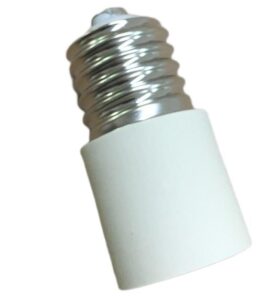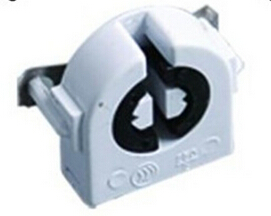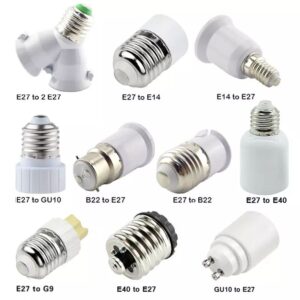A light socket not working can be caused by a number of things from a simple burned out light bulb to more complex wiring or electrical problems.
If a light socket is not working, check for simple things like a light bulb that has burned out, a dirty socket, a loose connection, bad wiring or a blown fuse.
Let’s go through each of these potential problems to help you troubleshoot a light socket that’s not working.

Is the bulb burned out?
One of the simplest explanations for a non-working bulb socket is that the bulb itself is burned out. Over time, bulbs naturally wear out, and their filament breaks, preventing them from illuminating when you flip the switch. This is particularly common with incandescent bulbs but can also happen with halogen, CFL, and even LED bulbs after prolonged use.
To check if the bulb is the issue, simply unscrew it and try it in another working socket. If the bulb doesn’t light up in the other socket, the bulb has likely burned out and needs replacing. This is an easy fix: purchase a new bulb with the appropriate wattage and install it in the socket.
Is the socket corroded or dirty?
Another common issue is corrosion or dirt inside the lamp socket. Over time, dust, dirt, and even moisture can accumulate in the socket, disrupting the electrical connection between the bulb’s base and the socket. Corrosion is more likely in humid environments or outdoor fixtures, where exposure to moisture can degrade the metal components inside the socket.
To fix this, first ensure the power to the socket is turned off. Then, clean the socket using a dry cloth, a small wire brush, or an electrical contact cleaner. Be sure to avoid getting the socket wet, as this can lead to short circuits or further damage. Cleaning can restore the connection and get the socket working again.

Is there a loose connection in the socket?
Loose connections inside the socket can also cause the bulb not to work. Over time, the electrical components inside the socket can loosen or wear out, especially if the fixture or lamp has been frequently handled. This loose connection can prevent electricity from properly flowing to the bulb.
To identify this, gently wiggle the bulb or the socket itself. If the light flickers on and off, a loose connection is likely the culprit. In this case, it’s best to turn off the power and inspect the wiring or the metal contacts inside the socket. If they are visibly loose, you may need to tighten them or replace the socket entirely to ensure a secure connection.
Is the switch faulty?
Sometimes the issue isn’t with the bulb or socket but with the switch that controls the fixture. A faulty switch can prevent electricity from reaching the socket, causing the bulb to remain off even though the socket is otherwise functional. This is especially common with older or heavily used switches, where internal components may wear out.
To test whether the switch is the problem, you can try toggling it several times or replacing the bulb in another socket controlled by a different switch. If other sockets work fine but the socket in question doesn’t, it’s worth testing or replacing the switch to restore functionality.

Is the wiring faulty?
Faulty wiring is a more serious problem that can prevent a bulb socket from working. Over time, wiring inside the fixture or the electrical system itself can become damaged due to wear, age, or exposure to heat and moisture. This can cause the socket to lose its power supply, rendering it useless even if the bulb and socket are in good condition.
If you suspect wiring issues, it’s crucial to have a licensed electrician inspect the fixture or socket. Faulty wiring can be dangerous, increasing the risk of electrical shocks or fire hazards. Avoid attempting DIY repairs on wiring unless you are experienced in electrical work, as it requires proper knowledge and tools.
Is there a blown fuse or tripped breaker?
A blown fuse or tripped circuit breaker can also stop power from reaching your socket. Fuses or breakers are designed to protect your electrical system from overloads, and if too much current flows through the system, they will shut down the affected circuits.
If your bulb socket suddenly stops working, check the breaker panel to see if the circuit has tripped. If it has, reset the breaker or replace the fuse. However, if the problem persists after resetting the breaker, it’s a sign of a larger electrical issue, and you should consult an electrician.
Is the socket damaged?
Sometimes, the light bulb socket itself may be physically damaged. This could be due to wear and tear, overheating, or even exposure to moisture, leading to cracks, melted components, or burned contacts. A damaged socket won’t make proper contact with the bulb’s base, preventing it from working.
To check for physical damage, turn off the power and closely inspect the socket. Look for any signs of burning, cracks, or melted areas. If you notice any damage, the socket will need to be replaced. You can replace it yourself if you are comfortable with basic electrical work or hire a professional to do it safely.

Is the fixture outdated or incompatible with modern bulbs?
If you’re using an older fixture, it may not be compatible with modern bulbs, particularly energy-efficient ones like LEDs. Older sockets were designed for incandescent bulbs, which require different electrical characteristics than LEDs. For example, if you’re trying to use a low-wattage LED bulb in a socket that was designed for higher-wattage incandescent bulbs, the bulb may not work properly, or it may flicker.
In this case, you may need to update the fixture or use bulbs specifically designed to work with older sockets. Ensure that the bulb’s voltage and wattage match the socket’s specifications to avoid compatibility issues.
Is there a voltage problem?
Voltage issues can also prevent a bulb socket from working. If the voltage supplied to the socket is too high or too low, the bulb may not receive the correct amount of electricity to function. Voltage fluctuations can result from issues with your home’s electrical system or the utility company’s power supply.
If you suspect a voltage problem, you can use a multimeter to test the socket’s voltage. If it’s outside the normal range (110-120V in most homes), consult an electrician to resolve the issue and prevent further damage to your electrical system.
The thing you need to do is check the light bulb, check the connections, check the power supply and think about if you need to fix or replace anything.













